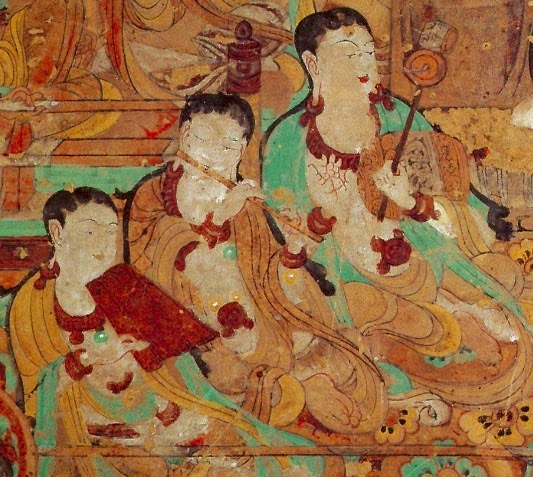Pipa 琵琶, four-stringed lute
Pipa and vertical flute, close up from Palace Concert.
The pipa is consistent with the description in most Tang texts: pear-shaped body, non-fretted, bent neck with four pegs, a pair of decorative fengyan 鳳眼 "phoenix eyes" openings on the sounding board, hugged sideways and played with a plectrum.
Dizi 笛子, flute
- Shudi 竪笛 (Vertical flute): made of bamboo; six holes, sometimes also called danguan 單管 (single reed).
Sheng 笙, mouth organ
The sheng is depicted on the left with the qin on the right. Sheng is made of bamboo pipes of varying lengths, numbering most likely from 13 to 19 during the Tang. It includes a base, a mouthpiece, and bamboo pipes. The sheng appeared in textual history as early as the Shijing (Lesser Odes, "Deer Cry").
Qin 琴, seven-stringed zither, aka guqin 古琴
Paiban 拍板, wooden clapper
Paiban is usually made of four to six thin pieces of wood, round on the top and rectangular on the bottom, bound together on the round ends and played with two hands holding the rectangular ends. Often seen portrayed as standing at the head of a musical procession.
Close-up of painting from Dunhuang Mogao Cave 159, a scene from the "Manjusri Transformational Tableaux" 文殊經變. The three musicians are playing the paiban (wooden clapper), the dizi (transverse flute), and sheng (mouth organ).
Close-up from Mogao Cave 220, "Bhaisajyaguru Sutra Transformation Tableaux" 藥師經變, Early Tang.
More close-ups from Mogao Cave 220. Two rows of musicians flank a dancer-musician in the middle. The following three images are details showing the left row, the right row, then the center dancer-musician respectively. For the whole image, see Pictures! page.
From left to right, paiban, dizi, and ?
From left to right: konghou-harp, lute, and the pipa.
The famous portrayal of dancer playing pipa held over and behind his head.
Pipa and vertical flute, close up from Palace Concert.
The pipa is consistent with the description in most Tang texts: pear-shaped body, non-fretted, bent neck with four pegs, a pair of decorative fengyan 鳳眼 "phoenix eyes" openings on the sounding board, hugged sideways and played with a plectrum.
Dizi 笛子, flute
- Shudi 竪笛 (Vertical flute): made of bamboo; six holes, sometimes also called danguan 單管 (single reed).
Sheng 笙, mouth organ
The sheng is depicted on the left with the qin on the right. Sheng is made of bamboo pipes of varying lengths, numbering most likely from 13 to 19 during the Tang. It includes a base, a mouthpiece, and bamboo pipes. The sheng appeared in textual history as early as the Shijing (Lesser Odes, "Deer Cry").
Qin 琴, seven-stringed zither, aka guqin 古琴
Paiban 拍板, wooden clapper
Paiban is usually made of four to six thin pieces of wood, round on the top and rectangular on the bottom, bound together on the round ends and played with two hands holding the rectangular ends. Often seen portrayed as standing at the head of a musical procession.
Close-up of painting from Dunhuang Mogao Cave 159, a scene from the "Manjusri Transformational Tableaux" 文殊經變. The three musicians are playing the paiban (wooden clapper), the dizi (transverse flute), and sheng (mouth organ).
Close-up from Mogao Cave 220, "Bhaisajyaguru Sutra Transformation Tableaux" 藥師經變, Early Tang.
More close-ups from Mogao Cave 220. Two rows of musicians flank a dancer-musician in the middle. The following three images are details showing the left row, the right row, then the center dancer-musician respectively. For the whole image, see Pictures! page.
From left to right, paiban, dizi, and ?
From left to right: konghou-harp, lute, and the pipa.
The famous portrayal of dancer playing pipa held over and behind his head.








No comments:
Post a Comment